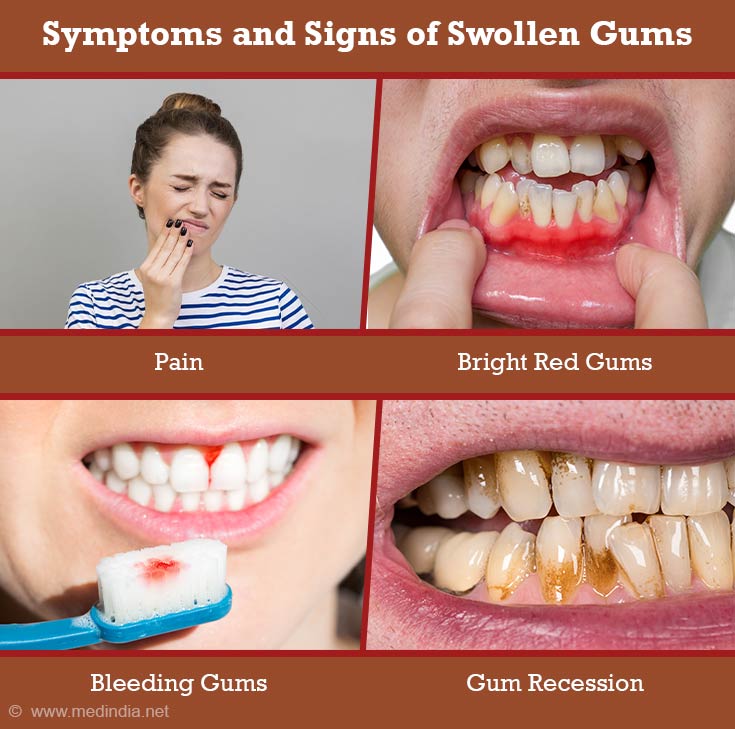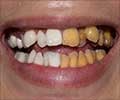- Gingivitis - Overview - (https://www.mayoclinic.org/diseases-conditions/gingivitis/symptoms-causes/syc-20354453)
- Gingival enlargements: Differential diagnosis and review of literature - (https://www.ncbi.nlm.nih.gov/pmc/articles/PMC4568527/)
- Gingival Crevicular Fluid: An Overview - (https://www.ncbi.nlm.nih.gov/pmc/articles/PMC6555362/)
- Swollen Gums - (https://my.clevelandclinic.org/health/diseases/24907-swollen-gums)
All About Swollen Gums
Gum swelling often signals gingival disease, but it can happen due to various reasons that make the gingiva tender and inflamed. Infections, hormonal changes, and not getting enough vitamins can lead to acute or chronic swelling in gums. Swollen gums usually turn reddish or purplish due to more blood flow. They might feel smooth or glossy and often bleed too.
What are the Causes of Swollen Gums?
Swollen gums are mostly due to infection of the gum. It happens because plaque, a thin layer of particles (from foods and drinks) and bacteria build up on the teeth.
The bacterial content of this plaque triggers a response from the gingiva, which results in swelling. Accumulation of white blood cells and fluids causes swelling, and these elements, in turn, counteract the action of the bacteria(1✔ ✔Trusted Source
Gingivitis - Overview
Go to source).
Due to certain normal conditions such as pregnancy and puberty, the gingiva may swell. This swelling is an abnormal response to the normal bacteria present in the mouth. This may be due to hormonal changes or variations seen during the above-mentioned conditions.
Certain diseases or deficiency conditions may also result in swollen gingiva. They are:
- Vitamin C deficiency
- Leukemia- cancer of blood cells
- Tumors or abnormal growth on the gingiva, which may be harmless or can be cancerous.
- Certain drugs used by the patient may result in increased size of the gingiva as a side effectg. Phenytoin used in Epileptic Fits, Nifedepine used for blood pressure(2✔ ✔Trusted Source
Gingival enlargements: Differential diagnosis and review of literature
Go to source).
What are the Symptoms of Swollen Gums?
- Pain may or may not be present.
- When there is an infection, the first stage is bright red gingiva.
- As the infection gets worse, the color of the gingiva tissue changes from red to bluish-red to deep blue. The gingiva becomes soft and spongy, and sometimes they might thicken due to scar tissue formation.
- Bleeding of the gingiva is another common symptom in the advanced stage.
- When the gingiva moves downwards, it exposes the root of the tooth. It can also affect the appearance of a smile in a way that might not look good cosmetically.
- Swelling caused by the drugs is usually very thick and hard. The swelling occurs when the drug is given for a specific duration.

How can we Diagnose Swollen Gums?
The physical appearance of the gingiva is sufficient to diagnose the condition. Gingival bleeding occurs when a thin metal diagnostic tool (probe) is gently passed along the tooth-gingiva edge which shows inflammation.
Gingival fluid measurement test
We measure the increase in the amount of gingival fluid in this test. Gingival fluid is a fluid produced by the gingiva in the space between the teeth and the gingiva called the gingival sulcus. Measuring the slight increase in gingival fluid requires special instruments and techniques. This is a specialized test for confirming swelling due to infection(3✔ ✔Trusted Source
Gingival Crevicular Fluid: An Overview
Go to source).
How can Swollen Gums be treated?
- If swelling is from soft plaque deposition, taking care of your teeth and gums with regular brushing and mouthwash can help reduce it.
- For tough plaque or trapped food, a dentist would be required to perform scaling to clean your teeth effectively
- If swelling is due to drugs, stopping the drug usage will substantially reduce the swelling
- In case of swelling due to general illness, correction of the underlying health problem usually results in an improvement
- If swelling is a tumor then surgical removal is recommended(4✔ ✔Trusted Source
Swollen Gums
Go to source).

To conclude, Proper dental care is essential for maintaining healthy teeth and gums. Swollen gums, often accompanied by bad breath, can signal underlying issues such as gum problems or tooth decay.
Proper dental care is crucial for healthy teeth and gums. Swollen gums, often with bad breath, might indicate gum issues or tooth decay.
Fluoride toothpaste strengthens tooth enamel, the hardest substance protecting teeth from decay.
The periodontal ligament (type of connective tissue) supports teeth, enduring chewing forces. 32 permanent teeth include different types of teeth including incisors, canines, premolars, and molars (including wisdom teeth). Each type has a role in food breakdown as they grind food.
Neglecting oral hygiene leads to periodontal diseases, harming soft tissue and ligaments. Regular dental check-ups and oral hydration prevent dry mouth, ensuring strong teeth and gums.










